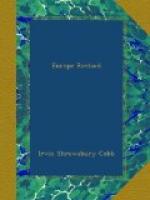The Germans prove they have a sense of humor by requiring their soldiers to march on parade with the goose step; and the French prove they have none at all by incasing the defenseless legs of their soldiers in those foolish red-flannel pants that are manufactured in such profusion up at the Pantheon.
In the event of another war between the two nations I anticipate a frightful mortality among pants—especially if the French forces should be retreating. The German soldier is not a particularly good marksman as marksmen go, but he would have to be the worst shot in the world to miss a pair of French pants that were going away from him at the time.
Still, when all is said and done, there is something essentially Frenchy about those red pants. There is something in their length that instinctively suggests Toulon, something in their breadth that makes you think of Toulouse. I realize that this joke, as it stands, is weak and imperfect. If there were only another French seaport called Toubagge I could round it out and improve it structurally.
If the English private soldier is the trimmest, the Austrian officer is the most beautiful to look on. An Austrian officer is gaudier than the door-opener of a London cafe or the porter of a Paris hotel. He achieves effects in gaudiness which even time Italian officer cannot equal.
The Italian officer is addicted to cock feathers and horsetails on his helmet, to bits of yellow and blue let into his clothes, to tufts of red and green hung on him in unexpected and unaccountable spots. Either the design of bottled Italian chianti is modeled after the Italian officer or the Italian officer is modeled after the bottle of chianti—which, though, I am not prepared to say without further study of the subject.
But the Austrian officer is the walking sunset effect of creation. For color schemes I know of nothing in Nature to equal him except the Grand Canon of the Colorado. Circus parades are unknown in Austria—they are not missed either; after an Austrian officer a street parade would seem a colorless and commonplace thing. In his uniform he runs to striking contrasts—canary yellow, with light blue facings; silvers and grays; bright greens with scarlet slashings—and so on.
His collar is the very highest of all high collars and the heaviest with embroidery; his cloak is the longest and the widest; his boots the most varnished; his sword-belt the broadest and the shiniest; and the medals on his bosom are the most numerous and the most glittering. Alf Ringling and John Philip Sousa would take one look at him—and then, mutually filled with an envious despair, they would go apart and hold a grand lodge of sorrow together. Also, he constantly wears his spurs and his sword; he wears them even when he is in a cafe in the evening listening to the orchestra, drinking beer and allowing an admiring civilian to pay the check —and that apparently is every evening.




